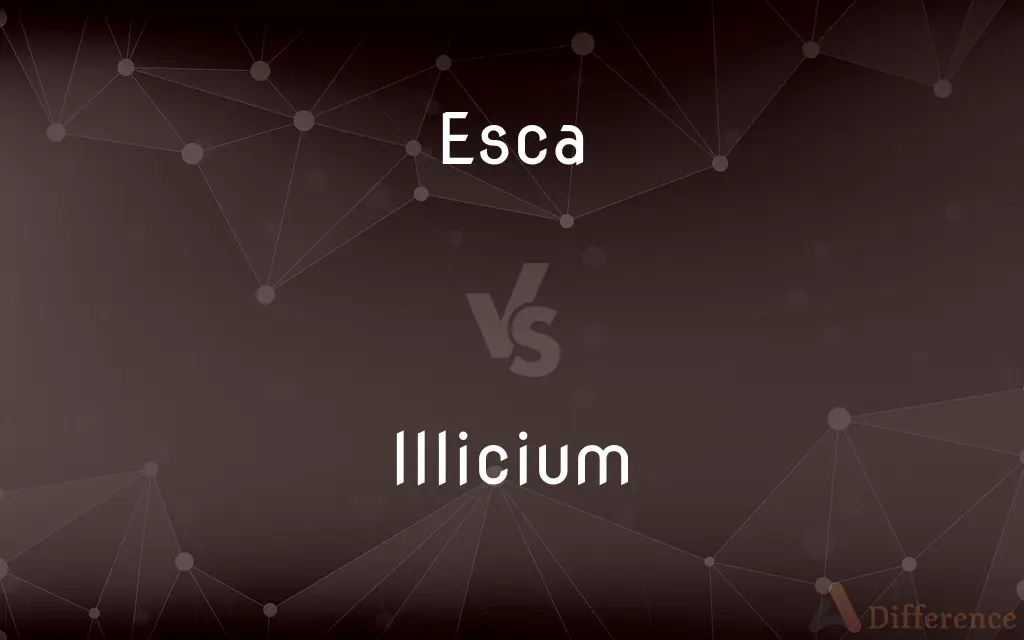Esca vs. Illicium — What's the Difference?
By Maham Liaqat & Fiza Rafique — Updated on March 21, 2024
Esca refers to the bioluminescent lure of deep-sea anglerfish, used to attract prey in the dark ocean depths. Illicium, on the other hand, is the term for the physical structure of the lure itself, which can hold the esca or emit light in some species.

Difference Between Esca and Illicium
Table of Contents
ADVERTISEMENT
Key Differences
Esca is a specialized feature of certain deep-sea anglerfish, serving as a bioluminescent beacon to attract unsuspecting prey in the pitch-black depths of the ocean. It is a part of a modified dorsal fin ray called the illicium, which acts as a fishing rod. On the other hand, illicium refers to the entirety of this "fishing rod" structure, which extends outward from the fish's head. The esca is the lure at the end of the illicium, which in some species, contains bioluminescent bacteria or other light-producing elements.
While the esca is specifically the light-emitting component that mimics the appearance of small prey or other attractive entities to lure predators or mates, the illicium is the anatomical feature that supports and displays the esca. This differentiation is crucial in understanding the anglerfish's unique predation technique, where the illicium's length and mobility allow precise control over the esca's placement.
The presence of esca and its function vary significantly across different species of anglerfish, with some using it for predation and others possibly for mating signals. Whereas, the illicium's structure and presence are more consistent among species, serving as a physical support regardless of whether the esca is used for luring prey or not.
The bioluminescence of esca is often symbiotic, relying on bacteria housed within the lure to produce light. This symbiotic relationship is a fascinating aspect of deep-sea biology, showcasing the complex interactions between species for survival. In contrast, the illicium itself does not produce light but is a critical structural component that enables the display and manipulation of the esca.
The study of esca and illicium offers insights into evolutionary biology, demonstrating how deep-sea anglerfish have adapted to their environment. The esca's bioluminescence is an evolutionary trait for attracting prey in the absence of light, while the illicium's evolution showcases the diversity of mechanisms in nature designed for survival and reproduction.
ADVERTISEMENT
Comparison Chart
Definition
Bioluminescent lure of deep-sea anglerfish.
The structure acting as a "fishing rod" for the esca.
Function
Attracts prey through bioluminescence.
Supports and manipulates the esca.
Relation to Light
Produces or houses bioluminescent elements.
Does not produce light but may be luminescent if esca is attached.
Biological Association
Contains symbiotic bacteria for bioluminescence (in some species).
Structural, without direct involvement in light production.
Evolutionary Aspect
Evolved for attracting prey or mates in dark environments.
Evolved to physically support and display the esca.
Compare with Definitions
Esca
Often houses symbiotic bacteria.
The esca's glow comes from bacteria living inside it.
Illicium
Does not produce light itself.
Though the illicium is vital, it does not glow without the esca.
Esca
A bioluminescent lure in deep-sea anglerfish.
The anglerfish's esca emitted a faint glow, attracting small fish.
Illicium
The "fishing rod" structure of anglerfish.
The anglerfish extended its illicium to hunt.
Esca
Part of the anglerfish's predatory mechanism.
The prey was mesmerized by the esca's light before being consumed.
Illicium
Present in all anglerfish, but varies in length and flexibility.
The species' illicium length varies, affecting its hunting tactics.
Esca
Can vary in function among species.
Some anglerfish species use the esca more for mating signals than for hunting.
Illicium
Supports the esca.
The illicium's length allows precise control over the esca's placement.
Esca
Used for attracting prey in dark environments.
In the deep sea, the esca is crucial for an anglerfish's survival.
Illicium
Critical for the anglerfish's predation technique.
The anglerfish relies on its illicium to lure and catch prey.
Esca
(ichthyology) The fleshy growth from an anglerfish's head that acts as a lure for its prey.
Illicium
Illicium is a genus of flowering plants treated as part of the family Schisandraceae, or alternately as the sole genus of the Illiciaceae. It has a disjunct distribution, with most species native to eastern Asia and several in parts of North America, including the southeastern United States, Mexico, and the Caribbean.
Esca
(phytopathology) A fungal disease afflicting grapes.
Illicium
(ichthyology) The modified dorsal fin on the head of anglerfish, acting as a lure.
Esca
A traditional Galician unit of dry measure, equivalent to about 6–9 L depending on the substance measured.
Illicium
A genus of Asiatic and American magnoliaceous trees, having star-shaped fruit; star anise. The fruit of Illicium anisatum is used as a spice in India, and its oil is largely used in Europe for flavoring cordials, being almost identical with true oil of anise.
Esca
A kind of measuring cup once used for measuring escas of grain.
Illicium
Anise trees: evergreen trees with aromatic leaves
Common Curiosities
What is the esca used for?
The esca is used to attract prey through bioluminescence in deep-sea environments.
How does the illicium function?
The illicium acts as a support and mechanism for manipulating the esca to lure prey.
How do esca and illicium contribute to anglerfish predation?
The esca attracts prey with light, and the illicium allows the anglerfish to control the placement of the esca.
Are esca and illicium present in all anglerfish?
While variations exist, most anglerfish have both an illicium and an esca, though their functions can vary.
Is the illicium always visible?
The visibility of the illicium can vary, as anglerfish can extend or retract it depending on their needs.
What's inside the esca?
Some escas house symbiotic bioluminescent bacteria, while others contain light-producing tissue.
Why is the illicium important?
It's crucial for the physical manipulation of the esca, enabling anglerfish to hunt effectively.
Do all esca emit light?
Most do, but the method and intensity of bioluminescence can vary among species.
Can the illicium be considered a unique feature of anglerfish?
Yes, it's a distinctive feature that sets anglerfish apart from other fish, crucial for their unique hunting method.
Can the illicium produce light?
No, the illicium itself does not produce light; it serves to support the esca, which may be luminescent.
How do anglerfish use the esca for mating?
Some species may use the esca's light as a signal for attracting mates, in addition to luring prey.
Are there different types of esca?
Yes, the appearance and function of the esca can vary significantly among anglerfish species.
How do anglerfish control their esca?
Through the illicium, anglerfish can precisely control the movement and placement of the esca to optimize hunting efficiency.
How did the esca evolve?
It likely evolved as an adaptation to the dark, deep-sea environment to attract prey.
Does the illicium have other functions besides supporting the esca?
Its primary function is to support and manipulate the esca, though its exact role can vary among species.
Share Your Discovery

Previous Comparison
Import vs. Importance
Next Comparison
Storey vs. FloorAuthor Spotlight
Written by
Maham LiaqatCo-written by
Fiza RafiqueFiza Rafique is a skilled content writer at AskDifference.com, where she meticulously refines and enhances written pieces. Drawing from her vast editorial expertise, Fiza ensures clarity, accuracy, and precision in every article. Passionate about language, she continually seeks to elevate the quality of content for readers worldwide.
















































